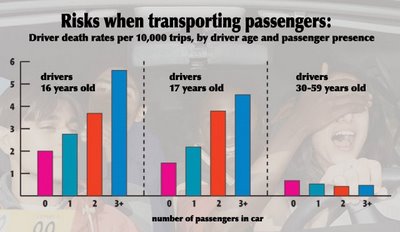wcco tv offered a terribly sad story on a young woman who died in a two-car collision yesterday. the piece followed-up with a brief discussion of graduated licensing, which places restrictions on the youngest and least experienced drivers.
one such restriction is the number of passengers that new drivers can transport. the wcco report showed a striking figure, similar to the department of transportation graphic shown below. for 16 and 17 year old drivers, death rates increase dramatically with the number of passengers in the car. for those aged 30 to 59, however, the number of passengers is unrelated to death rates.

distractibility is the hypothesized mechanism linking passengers to death rates for young drivers. i’d throw substance use into the mix as well, since the number of passengers is likely associated with alcohol and other substance use. in addition, i’d bet that peer passengers have a different effect than parent or sibling passengers — disaggregating by type of passenger might shed further light on the mechanism. as a 30-to-59 year old, my passengers today are often my kids. i still drive more recklessly with my buddies than i do with my kids, but i now spend much less time driving around with my buddies (what buddies?) than i did at age 16 or 17. if i’m correct, passenger type might be just as important as passenger numbers.
while i’m not sure whether a legal limitation on the number of passengers will reduce teen driving fatalities, the bivariate association is clear. when the figure flashed on the screen at my house, i couldn’t help overhearing the lad’s phone conversation. he was arranging to pick up a buddy or two before school. drive safe and keep the music down, dudes.

Comments